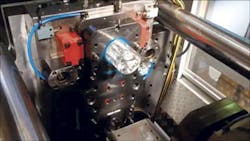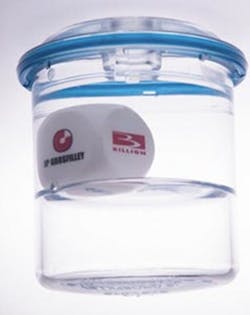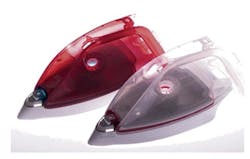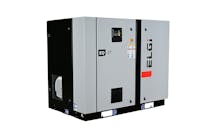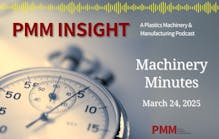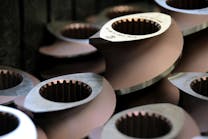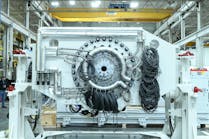As novelties go, there's probably not much value to a sealed cup containing a six-sided die bobbing in water. But, for mold maker J.P. Grosfilley, Martignat, France, the object represents proof of concept. All of it was made in just one cycle on one injection molding machine (IMM).
Blaine Coffey, company sales manager for the Americas, showed off the cup last month at KraussMaffei's open house. Though already available in Europe, the technology that yielded the product is in its infancy in the U.S.
Grosfilley's rotation molding process uses an index plate placed over a mold that moves like a gear in a clock, turning like a dial from one workstation to the next. In a simple example, a cup is molded with one material, the dial moves and a second material is allowed into the mold to create a second layer or new color.
"Materials are introduced through multiple injection units mounted on the IMM that are sized and timed for the correct volume of material," said Coffey, who works for both Grosfilley and its American representative, X-Cell Tool & Mold. "The index plate allows rotation of the mold and cavities to the accuracy of 1/100 of a degree."
Last month, Coffey said, the technology was recognized for its role in the production of a dashboard inlay for Ford Fiestas in Europe. To give the product a unique appearance, the mold was specially laser engraved. In production, clear PC was first injected into the mold, which then rotated to allow the injection of a substrate made of PC-ABS.
"You get a product that's really cool-looking, and you've made it less expensively," Coffey said. Because the process can be done entirely in the mold, it's also more repeatable, which eliminates the potential for waste.
So far, the company, which makes index plates for mono-, bi- and multirotation molding, can provide systems that handle as many as 10 workstations and six materials. It also makes "supercharged" versions that can handle materials with vastly different temperature requirements, such as liquid silicone rubber (LSR) and thermoplastics; such versions can be built to handle molds weighing as much as 12 tons.
"We're able to control now the temperature up to 200 C (392 degrees Fahrenheit)," Coffey said. He described how LSR can be injected cold and molded hot, "then the mold will index, it will rotate, and next to it, you can inject a thermoplastic." With another rotation, the materials — and the resulting part — can then be joined.
Because heating and cooling lines are connected through the center, the index plates have 360 degrees of play.
Coffey said that multirotation index plates and molds are appropriate for high-volume jobs. While existing IMMs can be retrofitted to accommodate the systems, he said most users adopt the technology along with new machines.
The technology is appropriate for a variety of parts, including automotive light lenses, pocket knives, hand tools and dashboard panels. In addition to eliminating the need for multiple molding machines or cycles, multirotation molding also reduces assembly steps. For example, welding can be eliminated because parts can be joined with heat; in the example of the water cup, even the water itself was injected.
Cycle times are dictated by the time it takes to complete the longest shot, Grosfilley Sales Manager Louis D'Amato said.
Coffey sees the process' efficiency as a key benefit for molders in the U.S. Because it eliminates steps, multirotation molding could allow them to better compete with overseas plants that use more labor-intensive approaches. He cited the example of making the body of a clothes iron, which once required a number of downstream steps and 12 people to produce.
"With one machine and this technology," he said, "it's now down to three." And, he said, that's not the only benefit: Because the process is repeatable, quality is up, too. The scrap rate has plummeted from about 20 percent to nearly zero.
"They were taking the component parts, welding them together ultrasonically, and you could see you couldn't get 100 percent accuracy," he said.
To ensure quality, the index plate for the iron even rotates to accommodate a pressure-testing step. Once the irons are tested, they're ejected from the mold — even with other irons in different stages of molding still in cavities.
For molders that have made big investments in downstream equipment, multirotation molding might seem unnecessary. The payoff in quality and labor — and future savings from assembly-work reduction — are factors worth considering, though, Coffey said. Reliability and repeatability are key.
"The faster you can do this, the cleaner we can do this, the greater return on the parts that are made," he said.
Karen Hanna, copy editor
khanna@plasticsmachinerymagazine.com
Contact:
X-Cell Tool & Mold Inc.,Fairview, Pa., 814-474-9100, www.xctam.com
Karen Hanna | Senior Staff Reporter
Senior Staff Reporter Karen Hanna covers injection molding, molds and tooling, processors, workforce and other topics, and writes features including In Other Words and Problem Solved for Plastics Machinery & Manufacturing, Plastics Recycling and The Journal of Blow Molding. She has more than 15 years of experience in daily and magazine journalism.
